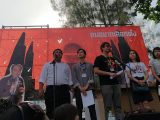Robert H. Goddard, the Father of NASA Climate Science and Renewable Energy
May 11, 2018 One of the odder takes is that NASA GSFC and GISS, both named for Robert H. Goddard, who is the US pioneer of rocketry, must return to its Buzz Lightyear roots. However, a little searching shows that as is often the case with those who value their attitudes above understanding, that they are clueless and that Goddard was indeed the father of NASA climate science.
One of the odder takes is that NASA GSFC and GISS, both named for Robert H. Goddard, who is the US pioneer of rocketry, must return to its Buzz Lightyear roots. However, a little searching shows that as is often the case with those who value their attitudes above understanding, that they are clueless and that Goddard was indeed the father of NASA climate science.In a 1920's presentation to the National Academy of Sciences, Goddard wrote
It is well understood that the pressure, temperature, wind velocity, and moisture content, which obtain at the top of the troposphere, i.e., at the 10 km. level, would be of much importance in weather forecasting; making possible the prediction of surface conditions many miles distant from the place of observation.
The data would obviously be of greatest value if obtained simultaneously at a number of separated stations. If this were done, an accurate weather map, representing conditions at a definite high elevation could be made, and compared with that representing surface conditions. Such a high altitude weather map would also be of obvious importance in aviation.Goddard worked through the requirements for an atmospheric sounding rocket program and discussed the need for a set of stations
In short, then, the most desirable method of obtaining high altitude data for weather forecasting, would consist in the sending of instruments to the 10 km. level daily, from a number of stations, the ascent and descent being as rapid as practicable; provision further being made, if desirable, for maintaining the instruments at this level during an appreciable interval of time.He was involved in testing instruments to be used to measure meteorological variables using sounding rockets as discussed in a 1920s letter to Science Magazine.
But, Goddard was not only the father of US rocketry and climate science, but also one of the earliest proponents of solar energy, holder of several patents on solar heat engines and concentrators. His contributions to solar energy, summarized in the early 1960s by Hagermann, were practical realizations of pie in the sky designs. In 1929, Goddard summarized one of his inventions
In conclusion it may be said that, instead of being a necessarily inefficient heat engine, the properly designed solar engine may rival in efficiency and smallness of bulk any other type of heat engine that can be imagined. This results from the easy utilization of very high temperatures, together with low heat and frictional losses. Expressed in another way, the properly designed solar engine is capable of handling enormously concentrated energy, such concentration of energy making possible maximum heat absorption, together with minimum heat loss, and minimum size. An interesting feature of the solar engine herein described is an extreme of lightness, for a given power, which no other type of heat engine can approach. This results from the small size, possibility of using light materials, and absence of weight of fuel.Eli shudders to think how Robert H. Goddard would have been described by Steve S Goddard, aka Tony Heller The Good Goddard was as a solar power enthusiast of the first water who developed practical and efficient solar powered engines and more. In 1929, he wrote in Popular Science about a small, 30 HP, concentrated solar motor he was working on that could reach an efficiency of 50% and be used to power large farms, with excess energy generated in the day being used to charge batteries. Goddard concluded that "The practical and obvious first use for the new solar motor however is to supply abundant and cheap power for mankind."
Hagermann has an interesting speculation about an alternative history
It is--from a solar-energy development point of view --too bad that Colonel Lindbergh persuaded the Guggenheims to give Goddard $100,000. For, instead of devoting his time to solar experimentation, Goddard removed his equipment from Camp Devens where he had been conducting static tests and went to Roswell, New Mexico, for flight tests on his own proving grounds.

